
Vincenzo Scamozzi was an Italian architect and a writer on architecture, active mainly in Vicenza and Republic of Venice area in the second half of the 16th century. He was perhaps the most important figure there between Andrea Palladio, whose unfinished projects he inherited at Palladio's death in 1580, and Baldassarre Longhena, Scamozzi's only pupil.

Andrea Palladio was an Italian Renaissance architect active in the Venetian Republic. Palladio, influenced by Roman and Greek architecture, primarily Vitruvius, is widely considered to be one of the most influential individuals in the history of architecture. While he designed churches and palaces, he was best known for country houses and villas. His teachings, summarized in the architectural treatise, The Four Books of Architecture, gained him wide recognition.
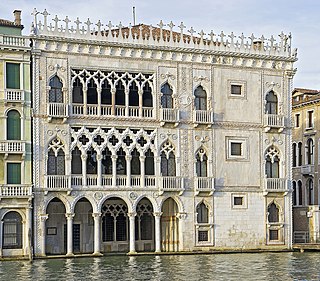
The Ca' d'Oro, or Palazzo Santa Sofia, is a palace on the Grand Canal in Venice, northern Italy. Ca' d'Oro or Cadoro translates to "House of Gold" or "Golden House" in English because of the gilt and polychrome external decorations that once adorned its walls. It was designed by Marino Contarini and later restored by Baron Giorgio Franchetti. In 1927, the building was converted into a museum and since then has been known as the Galleria Giorgio Franchetti alla Ca' d'Oro.

The Palazzo Tiepolo is a Renaissance-style palace located between the Palazzo Soranzo Pisani and the Palazzo Pisani Moretta on the Grand Canal, in the Sestieri of San Polo, Venice, Italy.
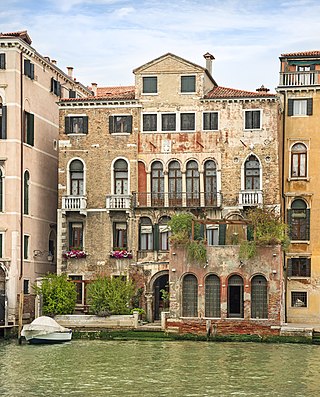
Palazzo Barzizza is a restructured formerly Gothic-style palace located on the Canal Grande of Venice, adjacent to the Palazzo Giustinian Businello in the Sestiere of San Polo, Venice, Italy. The opposite palace is Palazzo Cavalli.

The Palazzo Donà della Madoneta is a Gothic-style palace located on the Canal Grande of Venice, between Casa Sicher and Palazzo Donà a Sant'Aponal in the Sestiere of San Polo, Venice, Italy.

The Palazzo Genovese is a Gothic Revival-style palace located a few meters west of the Church of the Salute along the Grand Canal, the posterior facade abuts the church of San Gregorio in the Sestieri of Dorsoduro, Venice, Italy.

The Palazzo Giustinian Persico is an early-Renaissance-style palace located at the corner with the Rio di San Tomà, near Palazzo Tiepolo and across the canal from Palazzi Mocenigo on the Grand Canal, in the Sestiere of San Polo, Venice, Italy.

The Palazzo Fontana Rezzonico is a palace located on the Canal Grande of Venice, between the Rio di San Felice and Palazzo Miani Coletti Giusti in the Sestiere of Cannaregio, Venice, Italy.

The Palazzo Giusti, also known as the Palazzo Miani Coletti Giusti, is a Neoclassic-style palace located on the Canal Grande of Venice, between Ca' d'Oro and Palazzo Fontana Rezzonico in the Sestiere of Cannaregio, Venice, Italy.
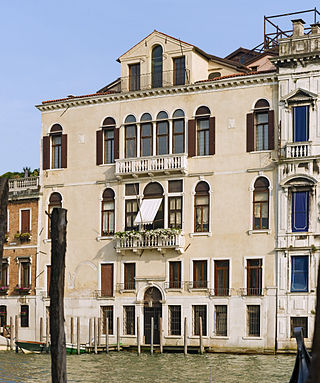
The Palazzo Corner Gheltof is Gothic-style palace located on the Grand Canal, in the Sestieri of San Marco, adjacent to the Palazzi Mocenigo, in Venice, Italy.

The Palazzo Ruzzini is 19th-century, neoclassic-style palace located between the Rio adjacent to the Fontego dei Tedeschi and the Casa Perducci and Palazzo Civran on the Grand Canal, in the Sestiere of Cannaregio, in the city of Venice, Italy. The central part of the facade is decorated with a trifora and quadrifora.

San Angelo degli Zoppi is a Gothic-style oratory or prayer hall, located in Campo Sant'Angelo in the Sestiere of San Marco, in Venice, Italy.

Palazzo Nani is a Renaissance palace in the Cannaregio district of Venice, Italy.
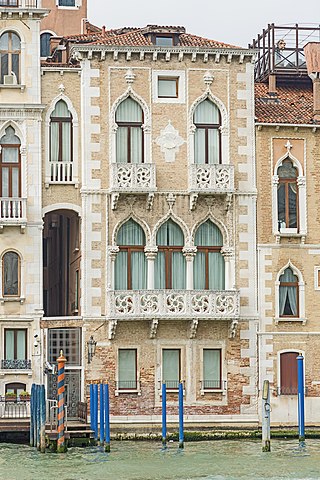
Palazzo Contarini Fasan is a small Gothic palace in Venice, Italy, located in the San Marco district and overlooking the Grand Canal. The palazzo is also called the House of Desdemona.

Palazzo Correr Contarini Zorzi is a Renaissance palace in Venice, Italy, overlooking the Grand Canal and locating in the Cannaregio district between Palazzo Querini Papozze and Palazzo Gritti. The palazzo is also known as Ca' dei Cuori, a family whose wrought iron coats of arms is present on the façade.
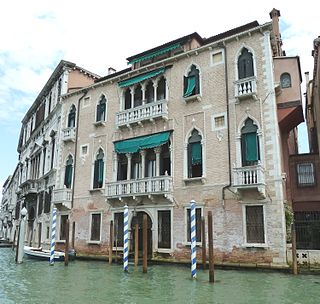
Palazzo Erizzo Nani Mocenigo is a palace in Venice located in the San Marco district and overlooking the Grand Canal between Palazzo Da Lezze and Palazzo Contarini delle Figure.
This is an alphabetical index of people, places, things, and concepts related to or originating from the Republic of Venice. Feel free to add more, and create missing pages.

Palazzo Corner Contarini dei Cavalli is a palace in Venice, located in the San Marco district, overlooking the left side of the Grand Canal, between the Rio di San Luca and Palazzo Grimani di San Luca on one side and Palazzo Tron and Palazzetto Tron Memmo on the other. The opposite structure is the Palazzo Papadopoli.



















